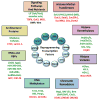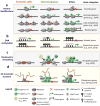Chromatin dynamics during cellular reprogramming
- PMID: 24153299
- PMCID: PMC4216318
- DOI: 10.1038/nature12749
Chromatin dynamics during cellular reprogramming
Abstract
Induced pluripotency is a powerful tool to derive patient-specific stem cells. In addition, it provides a unique assay to study the interplay between transcription factors and chromatin structure. Here, we review the latest insights into chromatin dynamics that are inherent to induced pluripotency. Moreover, we compare and contrast these events with other physiological and pathological processes that involve changes in chromatin and cell state, including germ cell maturation and tumorigenesis. We propose that an integrated view of these seemingly diverse processes could provide mechanistic insights into cell fate transitions in general and might lead to new approaches in regenerative medicine and cancer treatment.
Figures



References
-
- Takahashi K, Yamanaka S. Induction of pluripotent stem cells from mouse embryonic and adult fibroblast cultures by defined factors. Cell. 2006;126:663–676. - PubMed
Publication types
MeSH terms
Substances
Grants and funding
LinkOut - more resources
Full Text Sources
Other Literature Sources

